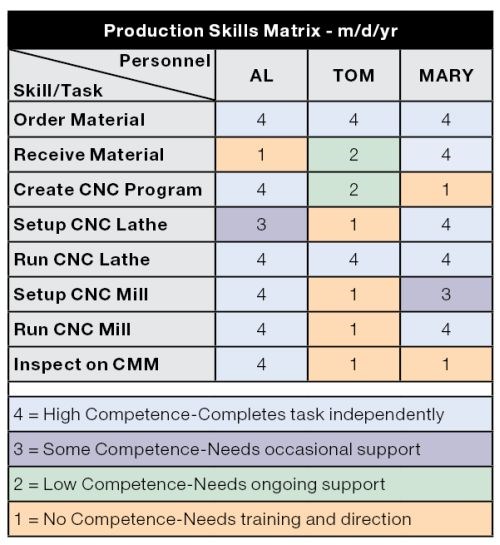This is an ideal situation, not only for the company, which benefits from a high level of productivity, but also for workers who have the opportunity to learn new things and increase their value to the organization.
Of course, the perfect workforce is not created overnight. Elevating each employee’s capabilities requires planning and management. The planning end requires identifying the critical skills or tasks that are required by the organization and allocating time for training (preferably, cross-training wherever practical) to develop proficiency. The management end requires evaluating employee competences and tracking the organization’s workforce training and development effort.
One tool I have found extremely useful in tracking the workforce training and development effort is an employee skills matrix. The matrix lists all key skills or tasks required by the organization and all employees working in the organization. Each employee is rated on his or her level of competence with each skill or task. Although there are many types of point scales that can be used for rating levels of competence, a simple four-point system works well, with four being the highest and one being the lowest.
An employee with a competence rating of four can complete a specific task independently. This would be your highest-skilled employee who has probably completed the task many times with good results. You can feel confident delegating a task to any employee with a rating of four.
A rating of three is for an employee who has demonstrated some competence on a given task. Although such an employee can complete the task, he or she may need occasional support, such as advice on the best way to resolve a problem, or another set of eyes to confirm that the task is being done properly.
A competence rating of two is for an employee displaying low competence and requiring ongoing support. Such an employee may have been trained on the task, but has not done it for some time. Or, the employee may have assisted someone else with the task in the past. This employee will require oversight and feedback as he or she strives to complete the task.
Finally, the lowest competence level, one, is intended for an employee who has not been exposed to the task. Such an employee requires training and direction before attempting the task, then extensive communication when he or she begins.
A color-coded employee skills matrix for a production department appears on page 34. As you can see, each employee is given a rating on each critical skill or task. There is also a place to date the matrix, as it is intended to be used and updated over time.
Although useful in black and white, it would be a little difficult to sort through the numbers and see the overall competence levels for each critical skill or task. The color coding amplifies the chart’s usefulness.
This “at-a-glance” chart enables companies to see the areas where they are strong, as well as those where they may be vulnerable. Likewise, it is much easier to see which employees need more training to increase their individual competence levels.
Using this example, the company can see that while it has sufficient competence in tasks such as ordering material, running the CNC lathe and running the CNC mill, it has fewer employees who can create CNC programs and inspect on a CMM. From an employee standpoint, the company immediately sees that Al and Mary have the highest levels of competence on the tasks critical to the production department, while Tom needs to increase his competence in these areas.
Developing a workforce is one of the most important things companies can do to ensure long-term competitiveness. A simple, yet highly visual employee skills matrix is a good tool to plan and manage workforce development efforts.


























